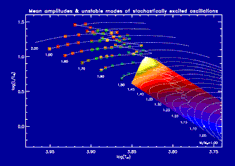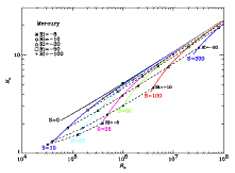|
|
|
|
Last Updated: Monday, 29 August 2022, 13:53 GMT
|
|
 |
|
Oscillation amplitudes and damping rates
In solar-like stars the acoustic oscillations are intrinsically damped but excited stochastically by the turbulent
motion of the gas in the outer stellar layers.Nonadiabatic model computations are necessary to estimate the
characteristic timescale over which the amplitudes of these oscillations decay. This demands a time-dependent
treatment of the turbulent fluxes of heat and momentum. The Figure shows a contour plot of the oscillation amplitude
in solar-type stars (brighter colours indicate larger amplitudes).
|
|
 |
|
Asteroseismic diagnostics
The design and analysis of low-degree seismic signatures of the structure of
spherical stars is of central importance to asteroseismic diagnosis. Spatially
localized inhomogeneities in any oscillating system impose an oscillatory component
on the frequency spacing of the oscillations.
By analysing the resulting oscillatory component the helium abundance,
for example, can be measured. The Figure shows the oscillatory component in the frequency spacing
for solar data.
|
|
 |
|
Convection dynamics
In stars with convectively unstable layers the stellar oscillations are coupled to the turbulent
velocity field. Consequently a time-dependent convection
model is needed for modelling the observed oscillation properties. Such a time-dependent
convection model has been tested successfully for radial pulsations.
It needs to be generalized to accommodate time-varying large-scale shear, so that it may then
be applied to gravity-mode pulsation in stars such as γ Doradus stars. The Figure shows the Nusselt number
as a function of Rayleigh number in Rayleigh-Bénard convection and for various values of the gradient Richardson number.
|
|
|


